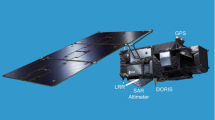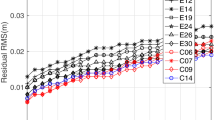Abstract
The processing of GPS radio occultation measurements for use in numerical weather predictions requires a precise orbit determination (POD) of the host satellite in near-real-time. Making use of data from the GRAS instrument on Metop-A, the performance of different GPS ephemeris products and processing concepts for near-real-time and real-time POD is compared. While previous analyses have focused on the achievable along-track velocity accuracy, this study contributes a systematic comparison of the resulting estimated bending angles. This enables a more rigorous trade-off of different orbit determination methodologies in relation to the end-user needs for atmospheric science products. It is demonstrated that near-real-time GPS orbit and clock products have reached a sufficient quality to determine the Metop-A along-track velocity with an accuracy of better than 0.05 mm/s that was formerly only accessible in post-processing. The resulting bending angles are shown to exhibit standard deviation and bias differences of less than 0.3 % compared with post-processed products up to altitudes of at least 40 km, which is notably better than 1 % accuracy typically assumed for numerical weather predictions in this height regime. Complementary to the analysis of ground-based processing schemes, the potential of autonomous on-board orbit determination is investigated for the first time. Using actual GRAS flight data, it is shown that a 0.5 m 3D rms position accuracy and a 0.2 mm/s along-track velocity accuracy can in fact be obtained in real-time with the currently available GPS broadcast ephemeris quality. Bending angles derived from the simulated real-time processing exhibit a minor performance degradation above tangent point heights of 40 km but negligible differences with respect to ground-based products below this altitude. Onboard orbit determination and, if desired, bending angle computation, can thus enable a further simplification of the ground segment in future radio occultation missions and contribute to reduced product latencies for radio occultation data assimilation in numerical weather predictions.





Similar content being viewed by others
References
Andres Y, Righetti PL, Marquardt C (2010) Near real-time precise orbit determination for radio occultation and altimetry missions, ION-GNSS-2010 conference, Portland
Anlauf H, Pingel D, Rhodin A (2011) Assimilation of GPS radio occultation data at DWD. Atmos Meas Tech Discuss 4:1533–1554. doi:10.5194/amtd-4-1533-2011
Anthes RA (2011) Exploring earth’s atmosphere with radio occultation: contributions to weather, climate and space weather. Atmos Meas Tech 4:1077–1103. doi:10.5194/amt-4-1077-2011
Ao CO (2009) Atmospheric sensing using GNSS occultations, chap. 15. In: Gleason S, Gebre-Egziabher D (eds) GNSS applications and methods. Artech House, Norwood
Bar-Sever Y, Bell B, Dorsey A, Srinivasan J (2003) Space applications of the NASA global differential GPS system, ION-GPS-2003 conference, Portland
Bertiger W, Wu S-C (1996) Single frequency GPS orbit determination for low earth orbitors, ION-NTM-1996, Santa Monica
Bonnedal M, Christensen J, Carlström A, Berg A (2010) Metop-GRAS in-orbit instrument performance. GPS Solut 14(1):109–120. doi:10.1007/s10291-009-0142-3
Culverwell I (2011) Radio occultation processing package (ROPP)—an overview, EUMETSAT, SAF/GRAS/METO/UG/ROPP/001, version 5.0. http://grassaf.org/grassaf_ropp_overview.pdf
Dach R, Brockmann E, Schaer S, Beutler G, Meindl M, Prange L, Bock H, Jäggi A, Ostini L (2009) GNSS processing at CODE: status report. J Geod 83(3–4):353–365. doi:10.1007/s00190-008-0281-2
Dow JM, Neilan RE, Rizos C (2009) The International GNSS service in a changing landscape of Global Navigation Satellite Systems. J Geod 83(3–4):191–198. doi:10.1007/s00190-008-0300-3
GRAS-SAG (1998) The GRAS instrument on Metop—report of the GRAS-SAG, VR/3021/PI, EPS/MIS/TN/97805, version 1.2, 4 May 1998
Hauschild A, Montenbruck O (2008) Real-time clock estimation for precise orbit determination of LEO-satellites, ION-GNSS-2008, Savannah (2008)
Healy S, Hamrud M, Fouilloux A, Rennie M (2012) Use of two-dimensional operators when assimilating GPS-RO measurements. In: IROWG 2nd workshop, Estes Park. http://www.irowg.org/docs/Presentation/healy.pdf
Hoaglin D, Mosteller F, Tukey J (1983) Understanding robust and exploratory data analysis. Wiley, New York
Jensen AS, Lohmann MS, Benzon HH, Nielsen AS (2003) Full spectrum inversion of radio occultation signals. Radio Sci 38(3):1040. doi:10.1029/2002RS002763
Klaes K, Cohen M, Buhler Y, Schlüssel P, Munro R, Luntama J-P, von Engeln A, O’Clerigh E, Bonekamp H, Ackermann J, Schmetz J (2007) An introduction to the EUMETSAT polar system. Bull Am Meteorol Soc 88(7):1085–1096. doi:10.1175/BAMS-88-7-1085
Kursinski ER, Hajj GA, Schofield JT, Linfield RP, Hardy KR (1997) Observing Earth’s atmosphere with radio occultation measurements using the Global Positioning System. J Geophys Res 102(D19):23429–23465. doi:10.1029/97JD01569
Loiselet M, Stricker N, Menard Y, Luntama JP (2000) GRAS—MetOp’s GPS-based atmospheric sounder. ESA Bull 102:38–44
Luntama J-P, Kirchengast G, Borsche M, Foelsche U, Steiner A, Healy S, von Engeln A, O’Clerigh E, Marquardt C (2008) Prospects of the EPS GRAS mission for operational atmospheric applications. Bull Am Meteorol Soci 89(12):1863–1875
Marquardt C (2009) GRAS offline bending angle validation, presentation at 24th GRAS Science Advisory Group Meeting, EUMETSAT, Darmstadt
Martinez Fadrique FM, Agueda Mate A, Sancho Rodriguez-Portugal F (2007) GRAS NRT precise orbit determination: operational experience. In: 20th international symposium on space flight dynamics, Annapolis
Montenbruck O (2007) GRAS2Rnx—a RINEX generation tool for the GRAS instrument; GRAS-DLR-TN-0010, issue 1.1 DLR/GSOC, Oberpfaffenhofen
Montenbruck O, Ramos-Bosch P (2008) Precision real-time navigation of LEO satellites using Global Positioning System measurements. GPS Solut 12(3):187–198. doi:10.1007/s10291-007-0080-x
Montenbruck O, van Helleputte T, Kroes R, Gill E (2005) Reduced dynamic orbit determination using GPS code and carrier measurements. Aerosp Sci Technol 9(3):261–271. doi:101016/jast200501003
Montenbruck O, Andres Y, Bock H, van Helleputte T, van den IJssel J, Loiselet M, Marquardt C, Silvestrin P, Visser P, Yoon Y (2008) Tracking and orbit determination performance of the GRAS instrument on Metop-A. GPS Solut 12(4):289–299. doi:10.1007/s10291-008-0091-2
Montenbruck O, Swatschina P, Markgraf M, Santandrea S, Naudet J, Tilmans E (2011) Precision navigation using a low-cost GPS receiver. GPS Solut. doi:10.1007/s10291-011-0252-6
Pisacane G (2002) Metop/GRAS NRT POD requirements, EUM.EPS.GSE.FAX.02.109 25 EUMETSAT
Poli P, Healy SB, Dee DP (2010) Assimilation of Global Positioning System radio occultation data in the ECMWF ERA–Interim reanalysis. Q J Roy Meteorol Soc 136(653):1972–1990. doi:10.1002/qj.722
Roselló Gulasch J, Silvestrin P, Aguirre M, Massotti L (2009) Navigation needs for ESA’s earth observation missions, IAA-B7-1401. In: 7th IAA symposium on small satellite for earth observation, Berlin
Silvestrin P, Bagge R, Bonnedal M, Carlström A, Christensen J, Hägg M, Lindgren T, Zangerl F (2000) Space-borne GNSS radio occultation instrumentation for operational applications. In: Proceedings of the ION-GPS-2000, Salt Lake City, pp 872–880
Springer T (2009) NAPEOS mathematical models and algorithms. DOPS-SYS-TN-0100-OPS-GN, ESA/ESOC, issue 1.0. ftp://dgn6.esoc.esa.int/napeos
von Engeln A, Healy S, Marquardt Ch, Andres Y, Sancho F (2009) Validation of operational GRAS radio occultation data. Geophys Res Lett 36:L17809. doi:10.1029/2009GL039968
von Engeln A, Andres Y, Marquardt C, Sancho F (2011) GRAS radio occultation on-board of Metop. Adv Space Res 47:336–347. doi:10.1016/j.asr.2010.07.028
Wermuth M, Montenbruck O, van Helleputte T (2010) GPS high precision orbit determination software tools (GHOST). In: Proceedings of the 4th international conference on astrodynamics tools and techniques, Madrid, ESA WPP-308
Yunck TP (2003) Spaceborne GPS for POD and earth science. In: Reigber C, Lühr H, Schwintzer P (eds) First CHAMP mission results for gravity, magnetic and atmospheric studies. Springer, Berlin, pp 42–51
Zandbergen R, Ballereau A, Rojo E, Andres Y, Romero I, Garcia C, Dow J (2006) GRAS GSN near-real time data processing. IGS workshop, Darmstadt
Acknowledgments
The study makes use of GPS orbit and clock products provided by Center for Orbit Determination in Europe (CODE) based on data from the global GPS monitoring network of the International GNSS Service (IGS). The support of both institutions is gratefully acknowledged. The NAPEOS software as well as the GSN near-real-time GPS orbit and clock data are products of the European Space Operations Centre (ESOC) and used by EUMETSAT under license of the European Space Agency (ESA). Finally, the authors would like to thank ECMWF for providing the meteorological data for validation of the bending angle products.
Author information
Authors and Affiliations
Corresponding author
Rights and permissions
About this article
Cite this article
Montenbruck, O., Hauschild, A., Andres, Y. et al. (Near-)real-time orbit determination for GNSS radio occultation processing. GPS Solut 17, 199–209 (2013). https://doi.org/10.1007/s10291-012-0271-y
Received:
Accepted:
Published:
Issue Date:
DOI: https://doi.org/10.1007/s10291-012-0271-y




